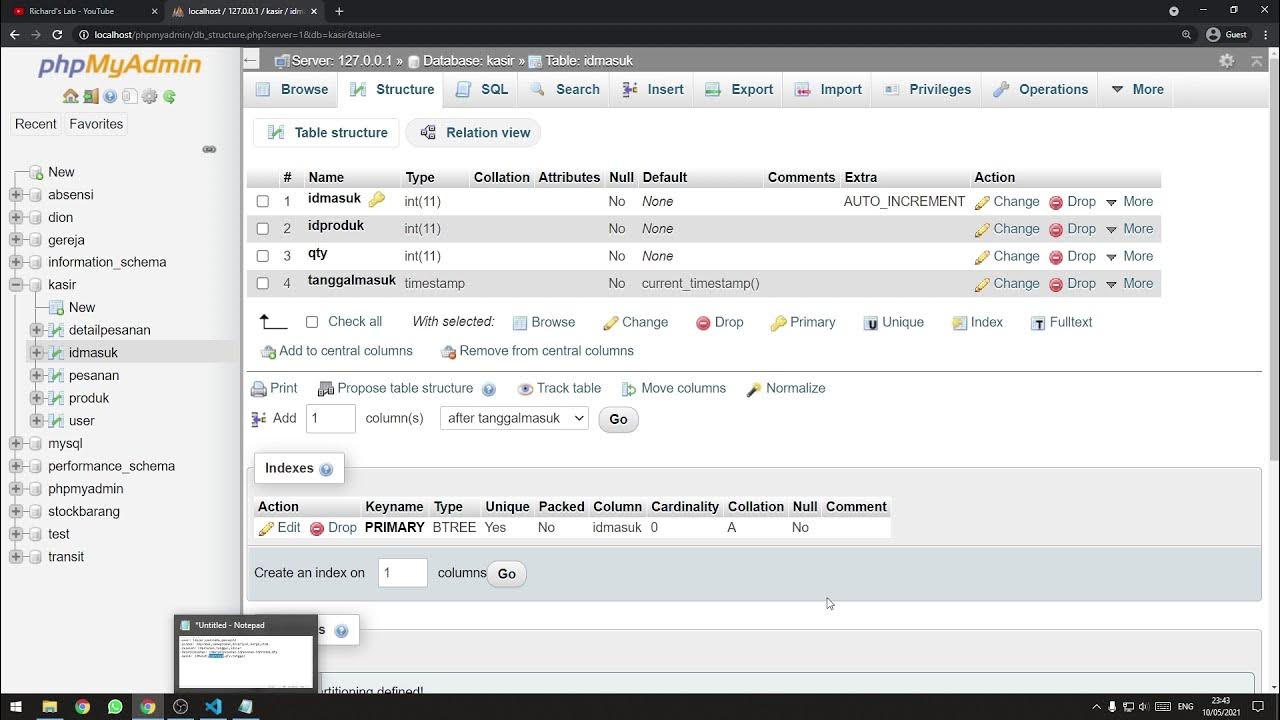96. OCR A Level (H446) SLR14 - 1.4 Data structures part 5 - Hash tables (operations)
Summary
TLDRThis video is the final part of a five-part series on hash tables. It covers essential operations like traversing, adding, and removing items from a hash table. The process involves using a hash function to calculate positions, handling collisions with an overflow table, and understanding how to search for items. The video emphasizes practical experience and understanding of hash tables over memorization. Additionally, the video promotes a book, *Essential Algorithms for A-Level Computer Science*, that provides comprehensive resources for learning data structures and algorithms, including coding in Python and VB.
Takeaways
- 😀 Hash tables are a key data structure, allowing for efficient storage and retrieval of data.
- 😀 In this video, we focus on traversing, adding, and removing items from a hash table.
- 😀 It's important to first understand the basics of hash tables before moving on to these operations.
- 😀 A hash table can be implemented in various ways, including using arrays or object-oriented approaches.
- 😀 For adding an item, we use a hash function to calculate its position in the table, then insert the item if the position is empty or handle collisions using an overflow table.
- 😀 To remove an item, we follow similar steps: generate a hash value, check the table, and use the overflow table if needed.
- 😀 When removing items, the item isn't truly deleted; the address is marked as available for future use.
- 😀 Searching for an item in a hash table involves generating a hash value and checking the table or overflow table for the item.
- 😀 Hash tables improve search efficiency, as items can be found directly through their hash value without long searches, except in cases of collisions.
- 😀 The video also highlights key exam requirements, including understanding how to create, add, remove, and traverse hash tables in different implementations.
- 😀 For deeper learning, the book 'Essential Algorithms for A Level Computer Science' is recommended, covering key data structures, algorithms, and exam preparations.
Q & A
What is the main focus of this video?
-The main focus of the video is to explain how to traverse, add, and remove items from hash tables, a data structure that was introduced in a previous video.
Why should viewers watch the previous video before this one?
-Viewers should watch the previous video to gain a foundational understanding of hash tables, which is essential before diving into more advanced operations like adding, removing, and traversing items in a hash table.
What is the significance of understanding different ways to implement a hash table?
-Understanding different ways to implement a hash table is important because the exam requires you to be able to trace and write code for hash table operations, using either procedural programming or object-oriented approaches.
What assumptions are made when adding an item to the hash table in this example?
-In this example, it is assumed that the initial text data is converted into numerical ASCII equivalents, a simple hash function (mod 10) is used, and an overflow table is employed to handle collisions.
How does the hash function work when adding an item to the hash table?
-The hash function takes the ASCII equivalents of the text (like 'florida'), processes them, and applies a mod 10 operation to calculate the hash value, which determines the position for inserting the item.
What happens if the calculated position in the hash table is already occupied?
-If the calculated position is already occupied, the item is inserted into the overflow table. If the first position in the overflow table is also occupied, the system will continue searching in a linear fashion until an empty position is found.
What is the procedure for removing an item from a hash table?
-To remove an item, the system generates the hash value, checks the hash table at the corresponding address, and if the item is found, it is deleted. If not, the overflow table is searched linearly until the item is found or the table is exhausted.
What happens to the item after it is deleted from the hash table?
-After an item is deleted, it is not actually removed. Instead, the address where the item was stored is marked as available for future use and can be overwritten later.
How is searching for an item in a hash table performed?
-Searching for an item involves generating the hash value, checking the corresponding position in the hash table, and if the item isn't found, the overflow table is searched linearly until the item is located or the table is fully searched.
What makes hash tables an efficient data structure?
-Hash tables are efficient because they allow quick access to data by calculating a hash value to directly locate an item, avoiding lengthy searches. However, additional searches are necessary if collisions occur.
Outlines

Dieser Bereich ist nur für Premium-Benutzer verfügbar. Bitte führen Sie ein Upgrade durch, um auf diesen Abschnitt zuzugreifen.
Upgrade durchführenMindmap

Dieser Bereich ist nur für Premium-Benutzer verfügbar. Bitte führen Sie ein Upgrade durch, um auf diesen Abschnitt zuzugreifen.
Upgrade durchführenKeywords

Dieser Bereich ist nur für Premium-Benutzer verfügbar. Bitte führen Sie ein Upgrade durch, um auf diesen Abschnitt zuzugreifen.
Upgrade durchführenHighlights

Dieser Bereich ist nur für Premium-Benutzer verfügbar. Bitte führen Sie ein Upgrade durch, um auf diesen Abschnitt zuzugreifen.
Upgrade durchführenTranscripts

Dieser Bereich ist nur für Premium-Benutzer verfügbar. Bitte führen Sie ein Upgrade durch, um auf diesen Abschnitt zuzugreifen.
Upgrade durchführenWeitere ähnliche Videos ansehen

91. OCR A Level (H446) SLR14 - 1.4 Data structures part 5 - Hash tables

Module08Video01

ServiceNow Table Relationships and Schema Map

[Part 1] Tutorial Aplikasi Kasir / Penjualan Berbasis Web PHP Native - Template + Setup Database

a level computer science tips from a straight a* student

92. OCR A Level (H446) SLR14 - 1.4 Data structures part 1 - Linked lists (operations)
5.0 / 5 (0 votes)
